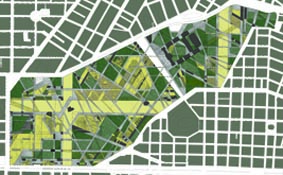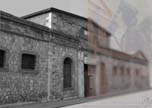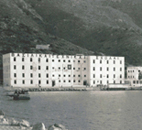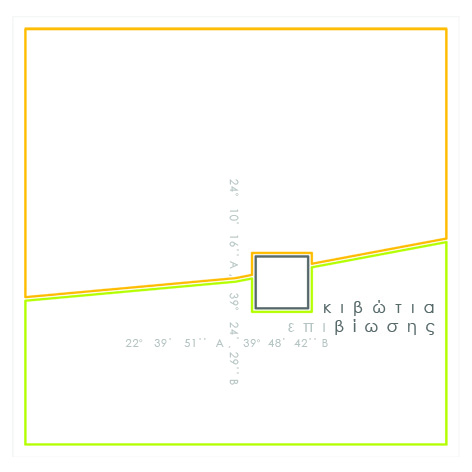

Pedion Areos is a big park located in the center of the urban plan of Athens. It is the second bigger green space in Athens after the National Garden. It is surrounded by the streets Alexandras, Mavromateon, Evelpidon, Moustoxidi, Bosgou and Valtinon. The place, named nowadays Pedio Areos, was till the 20s an open space situated in between the underpopulated districts of Gkizi and Kipseli. At first it was isolated from the web because of the streams and the few access points. Until the 30’s, there were the equestrian faculty, the Faculty of Evelpidon and at infringement of the city plan a veterinary clinic, the Geographical Service Of Army, 3 refugee settlements, cafes, a private school and two churches. The current form of the park was given in 1934. It was directly affected from the need of saving money and time and the fact that it was not possible to remove some installations before the planning. Later, the addition of green created discontinuities in the web. Today the park maintains the same, changed only regarding the uses. It is however neglected so that now assembles marginalized people and immigrants. Nevertheless, we can observe the genuine contact with public space and the inventiveness of use.
Reasons for planning were: the use of historical layers, new activities, the natural procedure, underlining the connection between nature and time and the social stratums which characterize this space. The respect in the existing situation and the process of evolution of the structured environment imposed the re-establishment of its cohesion that up to now is split by an "impenetrable" core of green. The central idea of the new plan begins from the fact that the space that today is named Pedio Areos constituted the void in between the two streams. This characteristic connected with the structured environment creates a mesh that results from the idea of connecting the banks of streams and continuity of urban void. This mesh is combined with the axis of Evelpidon faculty that its passage through the mesh of streets is twisted. More specifically the approach in the landscape aimed at the creation of two different but connected spaces: the "internal garden" and the "exterior landscape". The "internal garden" is a space drawn in the centre of region. It is an articulation of places and different sentiments and its identity is stressed by the alternation of hard and soft surfaces. On the contrary, the "exterior landscape" emphasises the functionalism, the sense of penetrability and indispensable possibility of reading the space via three axes that penetrate the park from one utmost to the other. Additionally, the “exterior landscape” embraces the limits of its sub-areas of internal garden, assembles the uses selected for the park and emphasises the arterial corridors but also the secondary ways, between the buildings and the green, that lead to the centre of the composition, to the internal garden. The dense and tall planting is situated in the limits of region and objects to the vertical urban elements of the city. There were drawn voids that attempt they encompass the history of place, in combination with the use of planting and different sizes. Natural and artificial, specifically selected plants and uses of buildings, are combined in surfaces, creating secondary centres of activities and their "outskirts". Generally, we can say that the character of this region is that of a landscape of gardens where the big groups of trees are placed between an articulated landscape of grass and coating.
Supervisor: Kanarelis Theoklis
Reference Number: 54


The study concerns the warehouse Harakoglou, located at 73 Pireos-Athinon Avenue. It consists of historical documentation of the building, pathology, building phases and a proposal for its conservation and reuse. The history of Pireos Avenue is connected with the history of Athens since the ancient times. The industrialization of the avenue begins at the end of the 19th century. Nowadays, the Ministry of Environment, Planning and Public Works, having recognized the importance for the protection to the industrial heritage, has listed as historic buildings many factories at the avenue, among them the Harakoglou warehouse.
The edifice was built at the beginning of the 20th century, as the Barbaresou Brothers Winery. In 1935 it was purchased by Evgenios Agapiou Evgenidis and since then has remained at the property of the Evgenidio Foundation. The rear section of the complex was demolished in 1965 and in 1972 the remaining structure was rented as a warehouse to Nikolaos Harakoglou. The architecture of the warehouse is in line with the general morphology of the industrial buildings of the period. Its characteristics are the functionalism of the internal space, the flexibility of the ground plan to later adaptations for production purposes, the severity and conformity to a rectangular grid and the rhythmical arrangement of columns and openings. The one or two-storied buildings were developed around a central courtyard at a symmetric way, which was strengthened by a blast furnace. The walls are of stone masonry. Demolitions and the requirements of the new uses led to off-hand completions and reconstructions which spoiled the initial character of the building. The problems at the existing building are due to the destructions which occurred during the Second World War, the human interventions and natural causes. Intense problems of dampness were recorded, while the stonework is further decayed by later rebuilding and cutting of new openings. Moreover, the roof and the upper floor of the central part were all demolished.
The proposal for the conservation and reuse of the building includes bringing back the existing building to its initial form, according to detailed documentation, and its completion at the demolished part with a modern building, in harmony with the old one. The design of the new building is based on certain characteristics of the existing, such as general axes and symmetry. Concerning new uses, in the old building a museum of cognac is proposed, while in the new one, recreation uses are suggested, like a café-theater, a musical stage and a restaurant, together with a center of alternative medicine and trade facilities, like a beverages shop, a confectionery and bookstore, relevant to the qualities of the drinks – such as flavor, feast and medical treatment.
Supervisor: Theologidou Cleopatra
Reference Number: 75


Arts and professions that once supported the trade and the economy of entire cities are disappearing; being unable to catch up new speeds and ways of life. Redefinition according to the new means , the possibilities, the contradictions and dynamic. If they are combined with technology that is developed rapidly and the vertiginous exchange of information, they might revive that glamorous past with future principals and create new places of “autonomous work” of the post-industrial city.
Spaces that die from indifference in the centre of post-industrial cities that remain incompetent to react.
In our days the significance of Post-fordism, signals a social model (which we can also consider as designing) where “the way of production is not dominated by forms of vertical incorporated accumulation … but by forms of flexible accumulation, capable of including different ways, years and places of production into the network: from the robot-type factory to the high-tech cheese dairy (cow house) and the Mexican Mequiladoras*… Essential is the connection between the information, the communication, the knowledge and the production… This is the cohesive web of Post-fordistic society”.
An enormous network of craftsmanship; a new type of “autonomous work” for the following era. Adapting, assembling and altering working spaces for the handicraft post-industrial production, which have been considered in various types.
Creative individuals, artists, craftsmen or teams of craftsmen can select between a whole of (applied) arts and techniques and afterwards they are being instructed in sectors of computers, economic management, organisation and distribution and they watch seminars on the selected craftsmanship. The next step is the choice of location (ex. some abandoned post-industrial building) and the acquisition of equipment. More specifically, the type of cabin that is entitled to the type of craftsmanship they chose.
Experimental Post-fordistic, professional cabins are placed into a building on the Ernestou Emprar street in Thessaloniki with possibility of spreading on the entire city.
The 36 cabins in the building, viewed as a micrograph of the world network, can initially function as an obvious example for the possibilities of interaction, collaboration, interpersonal forms of production and distribution, exchange of experiences and knowledge via internet.
The placement of teams of cabins in abandoned spaces can function dynamically and beneficially. The cabin expands and being accommodated in a scattered system of voids creating a craft “lace” in the existing urban web, the new type of work and new way of life lace. A placement like that differentiates the facets and the interior of these spaces. Progressively movement is perceived and the sense of shabbiness stops being unpleasant.
The cabins as “cages” or capsules that encompass energy; spread and revive the dead cells of wounded neighborhoods. Little shocks that can transform a series of legends and abandoned craftsmanship into reality and the haunted post-industrial castles into script production towers of the post-industrial society.
*Maquiladora (or maquila) are factories that import duty-free and tax-free materials and equipment, for assembling or manufacturing an object and then re-extract the assembled product usually back to the origin country. The main use of these installations is to assemble the imported parts. Maquiladoras usually belong in their 100% to the country that exports the materials.
Supervisor: Tzirtzilakis Yorgos
Reference Number: 92


The thermal baths of Thermopiles are found in the 200 km of the national road that connects Athens to Thessalonica, in the foot terms of the mountain Kallidromio. Between this natural limit and in the existing installations are organized the required spaces for the operation of baths. In this interval, is created a «container» capable to accept in his interior the various uses and the human body. A long, concrete wall fixes the extent of intervention and breaks it away from the environment of national road.
The interior of building is not organized as single space: with repeated aspects that are turned to the inside the visitor is broken away from environment space. He enters in another, foreigner with controlled escapes to the environment. The building accepts the passage of the hot water as if is directing it. In order to achieve the biggest enjoyment, the baths are drawn in such a way that is achieved overexcitement of senses. The light enters in the various rooms mainly from the openings of the roof and is engraved in the steams of the hot water. The absolute light is seldom met in the interior of building and it is used in order to it announce the beginning and the end of the root of the visitor with regard to the process of bath.
The closed units function as different loudspeakers for the sound of water that rolls in the raceway and runs along the building.
The existing concrete raceway is used as a mean of transfusion of water from the natural container where it is heated, in the container of building in order to receive the human body. Late on, the water ruptures the container, repeating the process of expense from the ground and shaping a second raceway in the level of soil. The water that comes out from the building meets in its course the water of waterfall and it is led to the sea.
Supervisor: Tzirtzilakis Yorgos
Reference Number: 61


In1912 the Italian army occupied the island of Leros and the area of Lakki became the center of Italian urban planning project for the mastery of the Levant. After the Treaty of Lausanne (1923) the Italians built the G. Rossetti air base in the area of Lepida, which pointed to the planning of the new town of Porto Lago (Lakki).
The air base spreads in the area of Lepida and Agios Georgios, where the Italian barracks stands. It was built between 1934 and 1936 and designed according to Italian rationalism standards.
In 1947 the Dodecanese appended to the Greek domain and the buildings of the air base lapsed to the Greek state’s property. From 1949 to 1960 the Italian barracks lodged the “Royal Technique School” –school for the “edification” of young rebels and orphans because of the civil war. At the fifties the Barracks lodged the mental clinic and in 1967 became prison camp for detainees because of the dictatorship.
This design project points out the reuse of the building and its success to a memorial dedicated to the detainees. It’s recommended the restoration of the barracks and its interior modulation with a new glass construction.
Supervisor: Tzirtzilakis Yorgos
Reference Number: 106


s u m m a r y
The initial objective of this project is the creation of a bifolding narration based on the combination of realistic and imaginative elements, as well in their in between interaction, while it is expressed in three additional levels of reference; those of the drawing work (the part that reflects the greatest amplitude of the project); those of written text; and those of the moving image.
b o x e s
Based on the extreme assumption of unidentified and unlucky concurrences which threat someone’s life and in the inexplicable presence of an inhabitable housing “box of survival” as a paradoxical and pre-existing provision, the two parallel narrations evolve on the one hand in an undeterminate time, whereas on the other hand they evolve in absolutely definite and actual locations.
Supervisor: Antonas Aristide
Reference Number: 107


